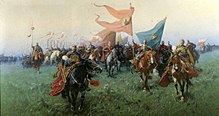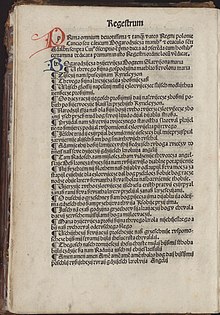Bogurodzica
This article needs additional citations for verification. (January 2016) |

Bogurodzica (Polish pronunciation: [bɔɡurɔˈd͡ʑit͡sa]; "Mother of God/Theotokos") is the world's oldest Polish anthem. It was composed somewhere between the 10th and 13th centuries. While the origin of the song is not entirely clear, several scholars agree that Saint Adalbert of Prague is the likely author.[1]
Polish knights sang it as an anthem before the Battle of Grunwald. Bogurodzica also accompanied the coronation ceremonies of the first Jagiellonian kings.
History

It was recorded in writing at the beginning of the 15th century. Two records preserved till today date back to that time:
- the Kcynia record including two initial stanzas together with musical notation;
- the Kraków record covering thirteen stanzas without notes.
Other records date back to the second half of the fifteenth century, the turn of the fifteenth and sixteenth centuries and to the beginning of the 16th century. In 1509 the song was printed in Kraków in Jan Łaski's Statut.[citation needed]
The origin of the song is not clear, although St Adalbert is a likely author.[2][1] It used to be related either to Latin liturgy, the tradition of church hymns, Greek or Old Church Slavonic influences, Western or Eastern culture. The two initial stanzas were created first - probably in the middle or at the end of the thirteenth century, or possibly at the very beginning of the fourteenth century.
Bogurodzica is a prayer hymn whose first stanza contains an invocation to Christ through the intercession of Mary. It begins with an apostrophe to her - to the Mother of Christ, the Virgin, praised by God, the chosen one. After the apostrophe, there is an appeal to Mary to win favour for people from her Son.
The second stanza begins with a direct addresses to Christ (called God's Son) - with an invocation to John the Baptist who can support human imploring. The prayer closing this stanza contains a request that Christ give people a blissful stay on earth and, after death, everlasting existence in heaven. The subsequent stanzas develop various motifs: Easter, the Passion, a litany - with invocations to the saints.
Bogurodzica was initially connected with the mass and procession but already in the fifteenth century it became a knight's battle hymn. Thanks to Jan Długosz (historian, author of Annales seu Cronicae incliti Regni Poloniae), we know that it was sung at Grunwald in 1410 as well as before other battles in subsequent years. It also accompanied the coronation ceremonies of Władysław III of Poland. That is why Długosz called Bogurodzica "carmen patrium" (the hymn of the fatherland). In the next centuries the hymn lost its significance. It regained its position of "carmen patrium" in the nineteenth century and has held it to the present day.
Lyrics
|
Polish[3] Twego dziela Krzciciela, bożycze, |
English[3] Son of God, for Thy Baptist's sake, |

Quotations in modern music
- Andrzej Panufnik - Sinfonia sacra (1963)
- Wojciech Kilar - Bogurodzica for choir and orchestra (1975)
- Krzysztof Meyer - Symfony No. 6 "Polish" (1982)
- Chłopomania - Bogurodzica (from Ludomania) (2008)
- Anna Witczak Czerniawska & Maleo Reggae Rockers feat Mazzoll - Bogurodzica (2015),
See also
References
- ^ a b A. P. Vlasto (1970). The Entry of the Slavs Into Christendom: An Introduction to the Medieval History of the Slavs. Cambridge University Press. p. 123.
- ^ Paula Jean Miller; Richard Fossey (2004). Mapping the Catholic Cultural Landscape. Rowman & Littlefield. p. 84.
- ^ a b Zawadzki, Jarek (2007). Selected Masterpieces of Polish Poetry. Jarek Zawadzki. ISBN 1-4196-7999-6.
Bibliography
- Bogurodzica. Oprac. J. Woronczak, wstęp językoznawczy E. Ostrowska, oprac. muzykologiczne H. Feicht, Wrocław 1962. Biblioteka Pisarzów Polskich.
- J.Birkenmajer, Bogurodzica Dziewica. Analiza tekstu, treści i formy, Lwów 1937.
- S.Urbańczyk, "Bogurodzica". Problemy czasu powstania i tła kulturalnego, w: Prace z dziejów języka polskiego, Wrocław 1979.
- A.Czyż, Bogurodzica - między Wschodem i Zachodem. Kilka myśli o duchowej jedności Europy, w: Światło i słowo. Egzystencjalne czytanie tekstów dawnych, Warszawa 1995
